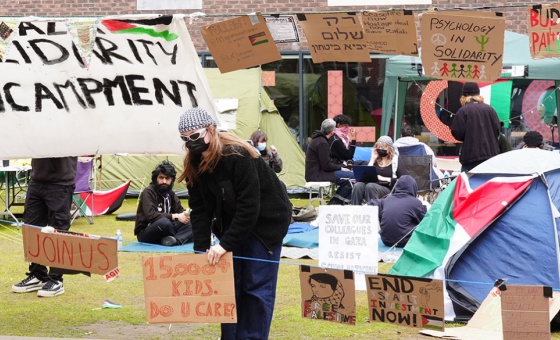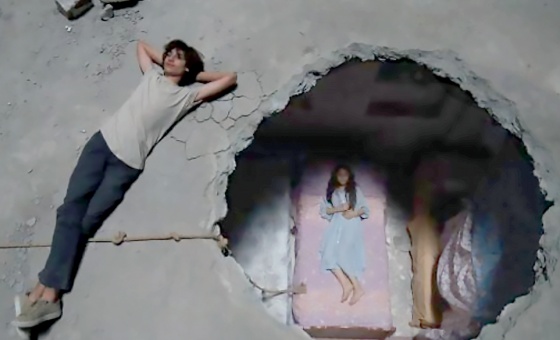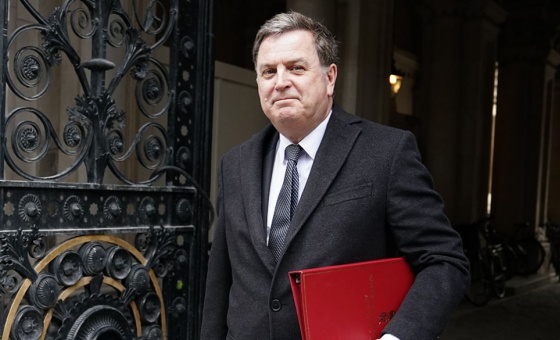This is the last article you can read this month
You can read more article this month
You can read more articles this month
Sorry your limit is up for this month
Reset on:
Please help support the Morning Star by subscribing here
Postwar Modern: New Art in Britain, 1945-1965.
Barbican
IF Jane Alison does little else in her career, she can look back on this lovingly curated show with pride.
Head of visual arts at London’s Barbican Centre, Alison has been in the job for nearly nine years; this exhibition has been two and a half in planning and execution. There are 48 artists represented, and some 200 works including painting, photography, sculpture and installations.
The curtain-raiser is John Latham’s Full Stop, a monumental piece with its giant black disk. A planet, black hole, an eclipse? One edge gives way to dots emerging — this full stop may not represent an ending, after all.
Alongside it, Francis Newtown Souza’s The Agony of Christ. The artist was already established in India when he moved to Britain. He was born in the Portuguese colony of Goa and brought up in post-colonial India — as a strict Catholic — and this was his rejection of a blond Christ. Souza’s is scourged and dripping, brutal, and black.
Refreshingly, there are plenty of female artists here, from Elizabeth Frink to Franciszka Themerson. The former’s bronze Harbinger Birds strut aggressively and seem a threatening presence. The latter’s surreal little figures writhe and jump through thick layers of oil paint, as in Eleven Persons and One Donkey Moving Forwards.
One woman grabs attention more than others. In a space dedicated to the work of Jean Cooke and John Bratby, there is trouble in the yearned-for nuclear family of the post-war years. Anyone who puts trust in gender stereotypes need only stand and witness Cooke’s Mad Self-portrait to understand this marriage. She has a black eye. This may be peacetime, though not in every home.
A canvas by Bratby shows Cooke beside a table full of breakfast cereal boxes and a Tate & Lyle sugar bag. The loaded table gives a nod to the year, 1954, when food rationing in Britain finally came to an end. This was a man who allowed his partner only three hours a day to make her own art. His certainly subverts any notion of domestic bliss — Cooke sits, naked, next to an open window.
You could say that this period was liminal, in society’s responses to war and its aftermath. That sounds soothing, though, and there’s more angst here. Curator Alison refers to a “discombobulation, an off-kilter-ness” and that’s a much more shrewd assessment. These artists had experienced the war at close hand, and the mixed emotions they’d felt and experienced in others are all reflected in their work.
Paolozzi’s Contemplative Object (Structure and Relief) could be a bomb, a seed or some asteroid; it suggests both death and birth, though perhaps not in that order.
This sits in a room dubbed Post-Atomic Garden, a space full of ambiguities, including the black and white prints by English documentary journalist Bert Hardy. His work for the phenomenal Picture Post included covering the D-Day landings, the liberation of Paris, and the horrendous sights at Bergen-Belsen. Here, his Leica has captured teenage shopgirl Betty Burden, adorable in her 1940s frock and hairstyle, pictured on the bombsite playgrounds of Birmingham in 1951.
From the ceiling looms Lynn Chadwick’s Fisheater, first commissioned for the Festival of Britain in 1951 and regarded as his masterpiece. It’s fragile and exquisite, but menacing too, this aircraft cum beast. It owes a debt to Chadwick’s turning point in 1941, when the former conscientious objector volunteered for the Fleet Air Arm, and spent the next few years as a pilot escorting Atlantic convoys.
There are merely a few duff notes in this symphony to British art. Welsh artist Sylvia Leigh painted her lover Lawrence Alloway, “cross-dressed” as a renaissance bride, in an elaborate gown she made for him. Or rather for his alter ego “Hetty Remington.”
Leigh was to move to the US, become a trailblazer in the feminist art movement and — in 1973 — paint The Turkish Bath, notable for its reversal of gender tropes and a poke in the eye for the male gaze.
The exhibition guide feels that the bride Alloway offers “a touching glimpse into their intimacy.” Touching or trite?
There’s a lot of fun in this multi-faceted show. An ice cream can, photographed by Shirley Baker on a Manchester street in 1965 is joyful. Look closely and the terraced houses are dim and drab. But the children and their mothers are in colourful dresses, cardigans and coats. Baker said she was struck by what she saw on the city streets, “…. the squalor and luxury, the sadness and joy, the brashness and elegance, the idleness and purposefulness…..” and she insisted that colour captured that best.
There are more well known names, among them Francis Bacon and David Hockney. The German-born Eva Frankfurther deserves her place here. Having fled Nazi Germany at the age of nine, she trained at St Martin’s from age 16. Throwing herself into the vibrancy of London, she chose to live in Whitechapel. Her portrait West Indian Waitresses with two women in sweet fatigue, is sublime.
I’d hoped this show would be gripping, and revelatory, and instructive. It is all those things. What I couldn’t have expected was to be so intoxicated by it that I got some odd thrill from this showcase of British art, as I’m neither an artist, nor particularly British. These pieces fill in a lot of gaps — not so much in knowledge, but in the visceral history of this period. Our families knew the real terror of war, the bombs and the bombsites, the traumatised refugees and the graves of loved ones.
As these artists worked, the 1960s promised a more colourful world, replete with modernity and luxurious comfort. If only we could tell these post-war creators the 2022 truth: we’d settle for peace.
To June 26
barbican.org.uk











